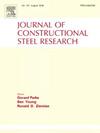Global reliability analysis-based optimization design of steel frame structure using direct probability integral method and genetic algorithm
IF 4
2区 工程技术
Q1 CONSTRUCTION & BUILDING TECHNOLOGY
引用次数: 0
Abstract
Traditional reliability-based optimization design faces challenges, such as difficulties in identifying failure modes and calculating correlation coefficients. To address these issues, this paper specifically investigates the optimization design problem of steel frame structures that meet normal serviceability performance requirements and develops a structural optimization design method based on the Direct Probability Integral Method and Genetic Algorithm (DPIM-GA). First, a joint probability density integral equation for the extremal mappings of multiple performance functions is derived based on the principle of probability conservation. The equation is solved with probability space partitioning and Dirac function smoothing techniques. Second, the performance function of the structural failure mode is identified, and the global reliability index of structures is calculated using DPIM with the Heaviside function. The global reliability index is used as a constraint condition and incorporated into the objective function through the penalty function method, transforming it into an unconstrained optimization problem. Additionally, to address the difficulty of obtaining performance functions of multi-layer structural systems through simple analytical formulas, a method employing response surface functions to fit the performance functions is proposed. Finally, a ten-story steel frame structural is used as a case, optimizing the cross-sectional design to meet the target reliability index. The optimized results are compared with Monte Carlo simulations (MCS) to verify the efficiency and accuracy of the proposed method.
基于直接概率积分法和遗传算法的钢架结构全局可靠性优化设计
传统的基于可靠性的优化设计面临着失效模式识别和相关系数计算困难等挑战。针对这些问题,本文具体研究了满足正常使用性能要求的钢架结构优化设计问题,提出了一种基于直接概率积分法和遗传算法(DPIM-GA)的结构优化设计方法。首先,基于概率守恒原理推导了多个性能函数极值映射的联合概率密度积分方程;利用概率空间分划和狄拉克函数平滑技术对方程进行求解。其次,识别结构失效模式的性能函数,并利用含Heaviside函数的DPIM计算结构的整体可靠度指标;将全局可靠性指标作为约束条件,通过罚函数法将其纳入目标函数,将其转化为无约束优化问题。此外,针对用简单解析公式求解多层结构体系性能函数的困难,提出了一种利用响应面函数拟合性能函数的方法。最后以某十层钢框架结构为例,对截面设计进行优化,使其满足目标可靠度指标。将优化结果与蒙特卡罗模拟(MCS)进行了比较,验证了所提方法的有效性和准确性。
本文章由计算机程序翻译,如有差异,请以英文原文为准。
求助全文
约1分钟内获得全文
求助全文
来源期刊

Journal of Constructional Steel Research
工程技术-工程:土木
CiteScore
7.90
自引率
19.50%
发文量
550
审稿时长
46 days
期刊介绍:
The Journal of Constructional Steel Research provides an international forum for the presentation and discussion of the latest developments in structural steel research and their applications. It is aimed not only at researchers but also at those likely to be most affected by research results, i.e. designers and fabricators. Original papers of a high standard dealing with all aspects of steel research including theoretical and experimental research on elements, assemblages, connection and material properties are considered for publication.
 求助内容:
求助内容: 应助结果提醒方式:
应助结果提醒方式:


